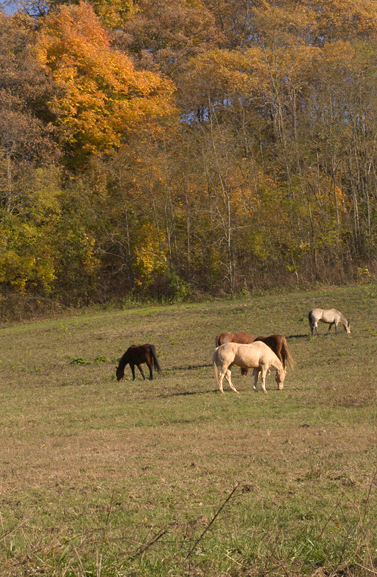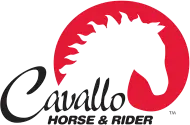Domestic Horses are Wild Horses

By Joe Camp
It’s true. Domestic horses and wild horses are genetically precisely the same. The horses in our back yard are really wild horses in captivity. Just like a baby tiger would be, even though his mom, grand mom, and triple-great grand mom were all born in captivity. That baby’s genetics are still the same as those beasts roaming the African jungles. The scientific fact, we discovered, is that it takes between 5000 and 10,000 years to even begin to change the base genetics of any species.
Which means the horses in our back yard have been programmed for millions and millions of years to live in wide open spaces where they can see predators coming, eat small bits of grass forage around the clock up to 18 to 20 hours a day, move 8-20 miles a day, on bare feet that can flex with each step to circulate blood within the hoof capsules, live with multiple horses for safety and security, and even balance their own diets if provided with enough choices to do so.
Who knew?
Obviously not us when we acquired our first horses, nor the experienced experts who were advising us with, This is the way it’s always been done! Our guys and girls all lived in a manner diametrically opposed to what their genetics were calling for. They lived in tiny little stalls where they could move at best 800 steps in a 24-hour day as opposed to the 8-20 miles a day their genetics called for. And we ultimately discovered that such a huge differential was not just affecting physical structure, it was affecting their digestion, their breathing, the health of their feet, and thereby immensely affecting their stress levels which, as medical science has finally come to realize, substantially affects all of their health. Their diet was mostly sugar in a bag, which we discovered is the absolute worst thing one can feed a horse, especially a confined one. Molasses is part of virtually every packaged feed in existence. Every grain in the same bag turns to sugar the instant it gets inside the horse. And, as mentioned above, horses are genetically programmed to eat grass forage (real grass or grass hay), little bits at a time, up to 18-20 hours a day. The horse’s hind gut is programmed to release digestive acid around the clock. Acid that digests grass hay (not sugar, not alfalfa, not pellets, not carrots, just grass hay). When that grass forage is not dribbling into the hind gut on a regular basis the acid has nothing to work on but the insides of the horse itself! Unlike humans whose digestive acid turns on and off depending upon whether food is present, the horse’s digestive acid never stops. So the grass forage needs to be there. Free-choice. Around the clock.

And then there’s the herd. We discovered that a horse in a stall who cannot commune with other horses gains yet another level of stress to endure. The purpose of the herd for a prey animal is safety and security. Being with other like animals is quite literally a safety net. There are more eyes to see trouble coming. And usually the dominant member of the group is also the number one watchdog. Being deprived of that comfort, at some level, breeds huge amounts of stress.
And please don’t ever let anyone tell you that horses should never eat green grass. Recently there have been a few voices out there claiming just that because the wild horses they studied were in an arid area of the Great Basin. But such a remark is scientifically incorrect. Horses have only been in the Great Basin for approximately 300 years. The wild horse evolved for those millions and millions of years in the American west from Texas through the Great Plains’ grasslands to the San Joaquin Valley and northward to the grasses of the Dakotas, Wyoming, Montana, Oregon and Washington. Horses are born to eat grass. Just be sure that when yours do, like in the wild, there are plenty of unfertilized native grass choices as well as other choices like weeds, brambles, berries, and trees so they can balance their own sugars which they are genetically capable of doing.
But as I mentioned earlier, we knew none of this a mere five years ago when we made the big leap into horses without a single clue. Maybe it helped, as they say, to come in with a clean plate. No baggage. No knowledge. Just an obsessive and compulsive urge to offer our new family members the very best life that we could. That urge-turned-insane-quest not only culminated in our herd living a life very close to the one they were genetically programmed to live, it spawned our first two books, The Soul of a Horse – Life Lessons from the Herd, a best seller thank you so much, and The Soul of a Horse Blogged – The Journey Continues, which together have changed the lives of thousands of horses and people all across the planet, for which Kathleen and I will be eternally grateful. Thankfully they are also humorous books. When you start where we started and really push the envelope there’s going to be a lot of stumbling around, a bunch of wrong turns, botched efforts, and, yes, stooopid mistakes. But, the trip has been so worth it and we are ever grateful to God for the opportunity to help make this planet a little better than we found it.

Which is why we needed to know all this. Our horses were born to be wild and we needed to know why. And what we should do about it. Cash, Mouse, Noelle, Mariah, Pocket, and Skeeter tell us how grateful they are everyday of our lives, and I can promise you there is no better feeling on earth.
Read more on The Soul of a Horse website
Joe Camp is the author of the national best seller The Soul of a Horse – Life Lessons from the Herd, The Soul of a Horse Blogged – The Journey Continues and his new series of eBook Nuggets from the Soul of a Horse. He is also the creator of the canine superstar Benji and the writer-director of all five Benji movies.
